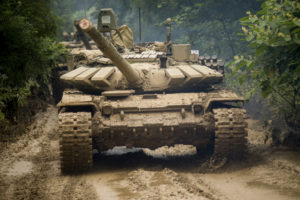Are Russia’s threatening troop movements just a play for better negotiating conditions? Many experts, including Ukraine’s leaders suspect just that. In Foreign Policy, Jeff Hawn, a doctoral candidate at the London School of Economics and Political Science’s department of international history, writes:
In early November 2021, several media outlets and the U.S. government began to warn of an imminent full-scale invasion of Ukraine by Russia on a scale not seen since the Iraq War of 2003. The attack was predicted to come around Christmas or in mid-January. Both dates have come and gone, and no invasion has materialized, yet some policymakers and most pundits continue to warn that it will happen, and soon. Moscow announced a series of demands on European security—unrealistic ones, but ones that seem set as a starting point for a dialogue among peers. This is a shift in the dynamic that Russia has been pushing for years: increasing its indirect confrontations with the United States to get America to treat it as a peer, not a spent force that can be ignored or dictated to.
The evidence so far points to Russia looking toward talks, not invasion. The initial reaction was set off by Russia’s movement of military assets within the Southern and Western military districts. The movements did not even represent a serious addition of forces to these command areas but a repositioning of different assets.
But there is a plausible argument that these are not a serious threat to Ukraine. In an article published in the Dutch-language magazine Knack and also on social media, Sim Tack, an independent military analyst (and previous co-author of mine) has noted that there has been more of a concentration of equipment than of personnel. He suggested last month that “Russia appears to experiment with forward positioning of equipment over longer durations of time than we usually see. They have done this first at Opuk between April and October, and now at Yelnya, Novoozerne, and Bakhchysarai. An emulation of NATO procedures in Eastern Europe.”
As Tack notes, the Russian air force has been largely absent from these movements. Air superiority would be a critical component of any ground offensive, so the lack of movement other than some helicopter formations is a major point against an imminent offensive.
Though on maps like the one published by the New York Times earlier this month Russian formations seem to be almost inside Ukraine, some are hundreds of miles away, lined up in depots at long-standing bases. There has been no effort to conceal the troops in forward positions or prepare them for an imminent offensive. Exercises in the Southern and then Western military districts have been interpreted as directed at Ukraine, yet these exercises were well within the scale of what is typical for Russia’s training schedule—and if units were being relocated to new areas as part of a reconfiguration, training and logistical exercises make perfect sense.
Ukraine’s leaders also do not appear to feel too threatened by Russia’s action. Yuras Karmanau reports in AP News:
Ukraine’s leaders sought to reassure the nation that a feared invasion from neighboring Russia was not imminent, even as they acknowledged the threat is real and prepared to accept a shipment of American military equipment Tuesday to shore up their defenses.
Russia has denied it is planning an assault, but it has massed an estimated 100,000 troops near Ukraine in recent weeks, leading the United States and its NATO allies to rush to prepare for a possible war.
Several rounds of high stakes diplomacy have failed to yield any breakthroughs, and this week tensions escalated further. NATO said it was bolstering its deterrence in the Baltic Sea region, and the U.S. ordered 8,500 troops on higher alert to potentially deploy to Europe as part of an alliance “response force” if necessary.
The State Department has ordered the families of all American personnel at the U.S. Embassy in Kyiv to leave the country, and it said that nonessential embassy staff could leave. Britain said it, too, was withdrawing some diplomats and dependents from its embassy.
In Ukraine, however, authorities have sought to project calm — while recent polls show that just half of the country believes an invasion is possible.
Speaking in the parliament on Tuesday, Defense Minister Oleksii Reznikov said that “as of today, there are no grounds to believe” that Russia is preparing to invade imminently, noting that its troops have not formed what he called a battle group that could force its way through the border.
“Don’t worry, sleep well,” Reznikov said. “No need to have your bags packed.”
Reznikov’s remarks come on the heels of multiple reassurances from Ukrainian President Volodymyr Zelenskyy and other officials. On Monday, Zelenskyy told the nation that the situation was “under control.”
If you’re willing to fight for Main Street America, click here to sign up for the Richardcyoung.com free weekly email.





